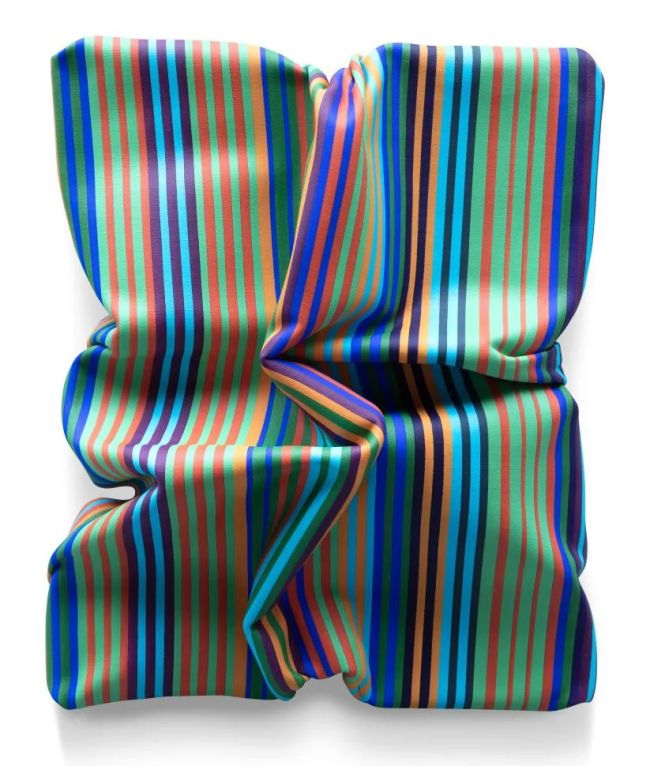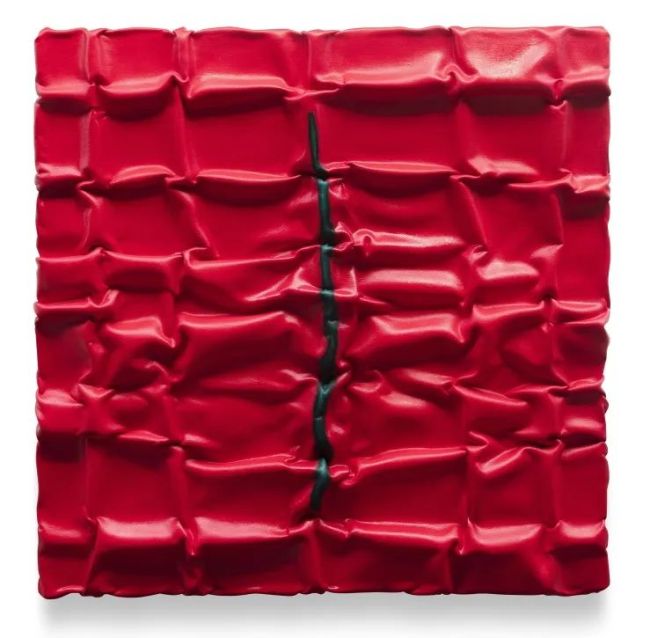凝视着维也纳艺术家美术馆的展览海报,一个疾驰前倾的身影,纵身迈步向左跨去,身后的发辫随之扬起,帽沿下半遮掩的脸庞,似乎感受得到他用力的呵气声,墙上映着他不成形的身影,空气中飘着一股躁动的气味,犹如暴走的灵魂在人间窜逃却无处可躲,这形态恰巧呼应了薄丘尼《独特的空间连续形式》,企图在静止中演绎速度,但这张海报里的人物却想在速度中追求静止,帮失控的情绪寻找心的方向。海报上不见任何作品,左下角的中文标题写着:王小松《失控的蚂蚁》。用“失控”两个字来形容艺术家矛盾、辩证、不妥协的创作动机,恰如其分,不仅是创作灵感的失控,也呼应了之后在平面画布创作上的失控。
On the exhibition poster hanged in the Vienna Artists Museum, a man is dashing forward, striding to the left, with the braid behind flying up and his half-covered face under the hat sensing his deep breath. With the shapeless shadow cast on the wall, and a smell of restlessness carried through the air, the image exclusively resembles an uncontrollable soul running away from the world only to find no place to hide. This picture responds exactly to Boccioni's Unique Forms of Continuity in Space, in which the figure is aerodynamically deformed by speed, while the figure on the poster is striving to pursue stillness in speed, assisting the uncontrollable emotions to find their inner direction. There is no artwork on this poster, but on the lower left corner of which writes its Chinese title: Unruly Ants by Wang Xiaosong. It couldn't be more appropriate than the word "unruly" to describe the artist's contradictory, dialectical and uncompromising creative motivation, which is also right to both his creative inspiration and the creation on the flat canvas.

王小松 无位性
Atopic
130x108cm 综合材料
2022年
王小松于2002年底从德国留学归国后,早期的创作风格仍停留在二维画布的探索上,《空层》(2010)和《失控的蚂蚁》(2012)便是此时期的代表,画面上线条如织,或成矩阵、或如人形、或成网状、或以文字乱码编排,密密麻麻地在平面画布上有序但不规律地编织着生命的符码,谱出了艺术家心中的哲学命题:生命的本质建构在有序的DNA和重组(失序)后所产生的异变。《五感》里的绿色,只是生命本质的一种铺陈,格子里填入的红和黄所编织出的点和线,才是驱动生命本质中五感的因子。
Wang's early creative style, after his return from Germany at the end of 2002, remains on the exploration of two-dimensional canvas, which is represented by the series of Empty Layer(2010)and Unruly Ants(2012). With lines crisscrossing on the canvas in the forms of matrices, human-figures, or networks, or garbled texts, he weaves densely the code of life in an orderly but irregular way on the flat canvas and composes a philosophical proposition in his mind: the essence of life is constructed in the orderly-mannered DNA and the mutation generated by recombination(disorder). The green color in Five Senses represents life itself, the dots and lines filled in the grid and woven by red and yellow are the factors that activate the five senses of life.

王小松 五感
Five Senses
160×220cm 油画
2006年
又如《轨迹》,以黑色矩阵编织成网,但每格黑框里所填进的红又跟黑产生不同程度的交融,当拉开视线,画面上的黑影有如鬼魅般的纠缠着本已受禁锢的红,氤氲沁漓,谱出一曲不安且多舛的命运交响乐。
As for Trajectories, it is woven into a net with black matrices, but the red filled in each frame has different degrees of integration with the black. While it is pulled afar, like ghosts the black shadows on the picture entangle with the imprisoned red, impressively composing a symphony of a hard and suffering fate.
这时期的作品,不管是以点线破坏面,还是在色调里做文章,或者像《抑郁者的情绪》,用不规则的红来破坏画面,皆试图在平面画布上探寻一个若即若离的空间感。之后,在《失落的幽灵》里,更以厚涂的重彩,勾勒出不成人形的幽灵,在阴郁的内心世界里苟延残喘,而那处混沌的蓝,正逐步堕向黑色的深渊;即使色彩明亮如《布达拉宫》的黄,画面上的人形仍摆脱不了灵魂在救赎前的挣扎与呐喊,而那些熬不住诱惑的躯体,已逐渐腐蚀败坏,形销骨毁,在画布上留下了无数的凹洞,这也是艺术家探寻空间的另一种形式,以色彩书写内容,以形式创造寓意。这个时期的作品是一种哲学性的思考,且在二维的画面上探讨空间的界限和延伸的可能性,直到2013年的《破界》,哲学性的思考逐渐升华为辩证,色彩从内容跨足到形式,平面画布的界限逐渐被打破,时间的概念若隐若现,王小松的创作又进入了另一个“失控”的时期。
The works of this period, no matter breaking the surface with dots and lines, or with colors, or irregular red as in Depression, are all seeking to explore a tentative space on the flat canvas. Later, in Lost Ghosts, with dark impasto strokes he sketches out formless ghosts struggling in their gloomy inner worlds, on which the chaotic blue is gradually falling into the abyss of black. Even with the color as bright as the yellow on Potala Palace, the human images still can't escape from struggling and screaming before the redemption of their souls, and those, who cannot resist the temptation, have gradually corroded and decayed, leaving nothing but countless concave holes on the canvas, which is another form of the artist's searching for space--endowing colors with content, and forms with meaning. The works of this period represent a kind of philosophical thinking, as he explores the boundaries and extension possibility of space on the two-dimensional picture planes. Up till Breakthrough of 2013, with his philosophical thinking gradually evolving into dialectical thinking, color-composed contents developing into color-composed forms, the edges of canvas plane slowly torn up, and the concept of time being indistinct, Wang Xiaosong's creation has entered another uncontrollable phase.

王小松 蠕动